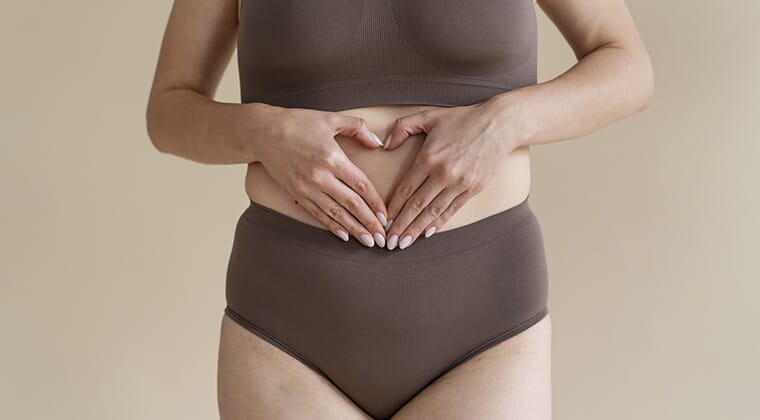PMDD awareness month may be drawing to a close, but for those with the condition life goes on. We take a deeper look into the condition, how to get a diagnosis and share advice from our experts on how to manage your symptoms.
What is PMDD?
Premenstrual Dysphoric Disorder (PMDD) is a severe form of premenstrual syndrome (PMS) which affects 5-10% of menstruating people. It is a combination of debilitating emotional and physical symptoms which occur during the week or two before your period. The combination of symptoms experienced can have a severely disruptive effect on many aspects of life and wellbeing. This is why it is so important to diagnose and find effective ways to manage and reduce symptoms.
What causes PMDD?
PMDD is classified as an endocrine disorder meaning that it is related to hormone levels and fluctuations. Research into the exact cause of PMDD is ongoing, but two key factors are thought to be:
- Sensitivity to normal hormone level changes. It is thought that PMDD is related to two hormonal changes. Firstly the rise in oestrogen and progesterone levels post-ovulation and a drop in serotonin levels- our ‘happiness’ neurotransmitter.
- Genetic predisposition that increases an individual’s sensitivity to hormonal changes.
There is additional research which suggests that PMDD could be triggered by trauma or extreme stress. Further research is still being carried out to explore exactly how and why this may happen.
What are the symptoms of PMDD?
PMDD symptoms vary from person to person, both in type and intensity. However, many people experience a combination of emotional, physical and behavioural symptoms some of which are listed below:
| Emotional | Physical | Behavioural |
| Mood swings | Breast engorgement and tenderness | Disrupted sleep routine |
| Feeling upset | Muscle and joint pain | Food cravings or bingeing |
| Feeling angry or irritable | Headaches and migraines | Lack of interest in relationships/ hobbies |
| Severe anxiety and overwhelm | Bloating | Trouble focusing and thinking |
| Lethargy and lack of energy | Panic attacks | |
| Suicidal feelings | Cramping | |
| Severe depression |
PMDD is related to the menstrual cycle, so these symptoms only occur during the week or two before your period and post ovulation. If your symptoms persist throughout your cycle, then it may be a sign of one of two things. Either you have another condition or you have PMDD and something else. PMDD is not thought to cause or be related to infertility.
How do you diagnose PMDD?
You will need to speak to your GP who will be able to diagnose your PMDD. They will usually need three things to ascertain if you have PMDD or not:
- A detailed record of your symptoms over at least two months. They may ask you to keep a symptom diary or provide you with a daily questionnaire to complete.
- Information about your medical history.
- Carry out some blood tests and a physical examination to rule out other medical conditions.
Unfortunately, it can sometimes take a while to get a diagnosis for a number of reasons. PMDD is not well known among individuals or even some healthcare professionals. This makes it harder to recognise and so diagnose the signs and symptoms. In addition to this, the symptoms are cyclical and come and go with your menstrual cycle, so it can be hard to notice the pattern. There are a few things you can do to both understand your symptoms better and help your GP to understand them too:
- Keep a record of your symptoms over time. This could be in a period tracking app or simply written down in a journal. If possible keep records for at least 3 months so that you can recognise patterns and triggers that make things worse.
- Take PMDD symptoms and treatment guidelines with you to your appointment. The following organisations have easy to follow but comprehensive guides on PMS and severe PMS (another name for PMDD).
- Ask your GP to refer you to either a gynaecologist or a mental health specialist. They may have a better understanding of PMDD and also treatment options.
- Our experts are here to talk through your symptoms and help you advocate for yourself.
Can PMDD be cured?
PMDD, unfortunately, has no cure, but with the right combination of treatments, symptoms can be managed to reduce the impact on your wellbeing and life. Here are some options your GP might offer:
- Antidepressants either in the run-up to your period or throughout the month. They can help improve your mood and alleviate depression.
- Painkillers or anti-inflammatory drugs like ibuprofen and paracetamol. These can help manage physical symptoms such as headaches and muscle pain.
- Combined oral contraceptives (the ‘pill’) which can reduce PMDD symptoms by stopping your menstrual cycle. For some people, the pill exacerbates their symptoms, so this may not be the best choice for everyone. Usually, your GP will suggest a three-month trial to see how you react to the treatment.
- Hormonal medicine (called GnRH analogues) in the form of injections or nasal spray which brings on temporary menopause. A common side effect of GnRH analogues is the loss in bone density which can put you at risk of developing osteoporosis. This means that treatment is usually limited to six months unless it’s combined with hormone replacement therapy (HRT) to reduce the menopausal symptoms and bone density loss.
If your symptoms are severe, your doctor may suggest:
- A bilateral oophorectomy (removing the uterus, ovaries and fallopian tube)
- A hysterectomy (removing the uterus)
PMDD and self-care
Part of managing your PMDD and alleviating symptoms is incorporating practices that help you get to know your cycle better and support both your physical and emotional wellbeing. With the current COVID-19 pandemic, stress and changes to your routine may be triggering your symptoms even more. So, here are a few tips that you can practice in the comfort of your own home to help you take care of yourself and manage your symptoms.
- Get to know your cycle: It may take a few months to see a pattern, but keep track of your moods, emotions and physical feelings every day for a few months. In this way, you will be able to see patterns in your symptoms, what triggers it, when it starts and what makes it worse or better. Once you know your own rhythm you can plan ahead and arrange things in line with your symptoms. This may include planning relaxing activities or things that will help cheer you up and rearranging stressful events for when you know you will feel better.
- Incorporate relaxation practices into your routine: Find something that you enjoy and that you can easily make time for as part of your daily routine. Some of our suggestions include:
- Switch off your phone for 20 minutes and read a book
- For 5 minutes at the start or end of your day, practice mindful breathing
- Prioritise yourself: Looking after yourself should always be your top priority throughout the month, good self-care can help manage the severity of some PMDD symptoms. Remember you can’t pour from an empty cup and cannot be of use to others if you yourself are not well.
- Make sure you’re getting enough sleep, which will give you more energy to cope with and manage challenging feelings and emotions.
- Ensure that you are eating well which means a nutrient-rich diet, high in omega 3 & 6, low in sugary foods. This will regulate your blood sugar levels, keeping your energy level stable, as well as helping to stabilise your mood.
- Stay active throughout the month, and although it may be difficult in the weeks leading up to your period, it may help you to relax.
- Try complementary therapies: Agnus Castus, Red Clover and St John’s Wort are all showing promising results in randomised controlled studies of reducing PMDD symptoms (but more data are needed). You can order these extracts online either in liquid form or capsules.





